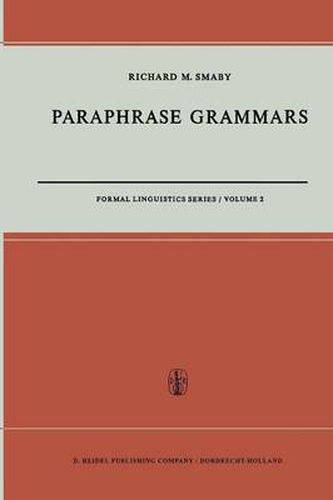Readings Newsletter
Become a Readings Member to make your shopping experience even easier.
Sign in or sign up for free!
You’re not far away from qualifying for FREE standard shipping within Australia
You’ve qualified for FREE standard shipping within Australia
The cart is loading…






This title is printed to order. This book may have been self-published. If so, we cannot guarantee the quality of the content. In the main most books will have gone through the editing process however some may not. We therefore suggest that you be aware of this before ordering this book. If in doubt check either the author or publisher’s details as we are unable to accept any returns unless they are faulty. Please contact us if you have any questions.
The recent rapid development of transformational grammars has incorpo rated some strong claims in the areas of semantics and co-occurrence. The earlier structuralists relied on a minimum of information about the meaning of strings of a language. They asked only if strings of sounds were different in meaning - or simply were different words or phrases. Current transfor mational grammars, on the other hand, set as their goal the production of exactly the meaningful strings of a language. Stated slightly differently, they wish to specify exactly which strings of a language can occur together (meaningfully) in a given order. The present book purports to show that transformational grammar is in dependent of the current trends in semantics. I claim that exciting and sophisticated transformational grammars are required for describing when strings of a language mean the same, that is, for describing when strings of a language are paraphrases of each other. This task can be quite naturally limited to a project of much weaker semantic claims than those which are current in transformational linguistics.
$9.00 standard shipping within Australia
FREE standard shipping within Australia for orders over $100.00
Express & International shipping calculated at checkout
This title is printed to order. This book may have been self-published. If so, we cannot guarantee the quality of the content. In the main most books will have gone through the editing process however some may not. We therefore suggest that you be aware of this before ordering this book. If in doubt check either the author or publisher’s details as we are unable to accept any returns unless they are faulty. Please contact us if you have any questions.
The recent rapid development of transformational grammars has incorpo rated some strong claims in the areas of semantics and co-occurrence. The earlier structuralists relied on a minimum of information about the meaning of strings of a language. They asked only if strings of sounds were different in meaning - or simply were different words or phrases. Current transfor mational grammars, on the other hand, set as their goal the production of exactly the meaningful strings of a language. Stated slightly differently, they wish to specify exactly which strings of a language can occur together (meaningfully) in a given order. The present book purports to show that transformational grammar is in dependent of the current trends in semantics. I claim that exciting and sophisticated transformational grammars are required for describing when strings of a language mean the same, that is, for describing when strings of a language are paraphrases of each other. This task can be quite naturally limited to a project of much weaker semantic claims than those which are current in transformational linguistics.